I grew up in the Northern Metro Detroit area. The earliest signals I remember in the early 1970's were eight inch eagle 4 way clusters at almost every intersection of two lane roads, most of which are now five lane roads or divided highways with twelve inch polycarbonate signals made by eagle durasig or
LFE.
Here are pictures of a couple of the old eagle clusters that are still left. These are in South Eastern Oakland County. What stands out to me with these signals is the use of tunnel visors on the red and yellow indications and cut away on the green.
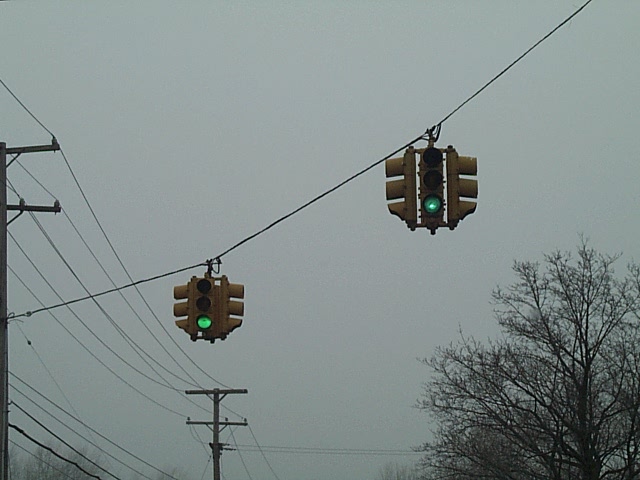
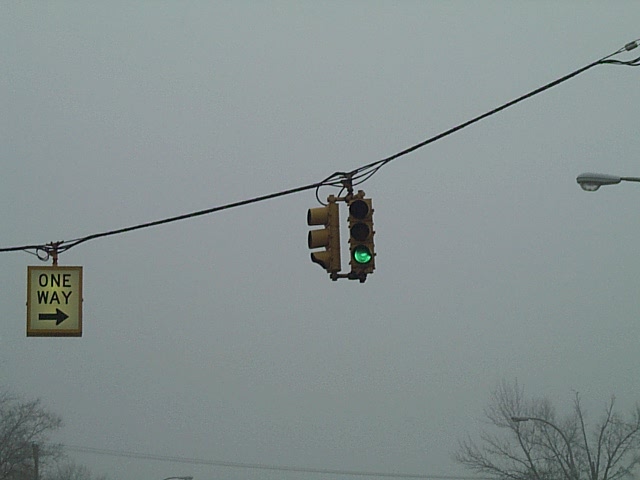
The signals above are the type where each section is its own closed housing with a small hole on the top and bottom for a hanger or connection to another signal section. Older signal heads like those shown below were open on the end of each section and required an end plate at the top and bottom of the signal. The entire head was held together with two rods passing from the top end plate through the signal bodies down to the bottom end plate and nuts were screwed on both ends of the rods. These signals below are Eaglelux heads. They have an end plate with a decorative "fin" on them which is similar to Crouse Hinds Art Deco signals.
The cluster with the green light on is a close up of the left cluster in the first Eaglelux picture.
Here is an unusual set up. The signals are all older 8 inch aluminum eagle signals, with the exception of the green arrow being a 12 inch lens. What is unusual is the position of the left hand through signal. Normally all through signals will be on the right side of a LEFT turn signal. Here the LEFT signal is between the two through signals.
Here is an example of a modern Michigan installation. The signals are all 12 inch poly heads. They are usually made by LFE or Durasig. These particular signals are LFE's. The right turn arrows for traffic on the North and South bound road let this traffic turn right when traffic on the cross street gets a green left turn arrow. All thru traffic is stopped when this happens. Then when the North and South bound road gets a green left turn arrow, the cross street traffic gets a right turn arrow.
UPDATE! This style of intersection is rapidly being replaced by box span intersections where the signals are not hanging in clusters, but single heads by themselves on span wires that form a box over the intersection. Also, the old Michigan flashing red ball left turn signals are rapidly being phased out and replaced with the national standard of a flashing yellow arrow 4 section head.
Below is a picture of a box span setup where each direction has a wire across the road with signals arranged as shown.

The
box span above is what is replacing most older intersections in Michigan now,
but in a few areas the diagonal span has
been used with the new flashing yellow arrow left turn signal, which puts a
monster 4 section 4 way signal right in the middle of the intersection as shown
below.
Videos of these setups can be viewed on the video page.

Now here are some old signals that I did not even know were here until April 14th 2002. These are Crouse Hinds single section single face art deco signals used as a two way stop. There are two of these two way stops with in a block of each other. I have two pictures from the day I discovered them which are the foggy pictures and two pictures from a week later when the weather was much nicer. They even have the old smiley lenses!
UPDATE!
Unfortunately, these signals were removed from service and
only STOP signs remain at the intersections. The removal likely took place
sometime in late 2004 or early 2005.
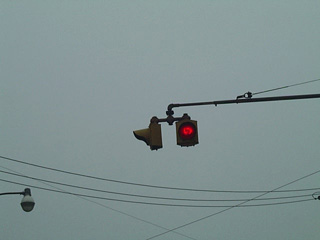
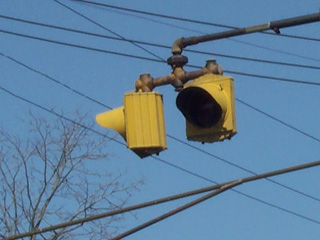
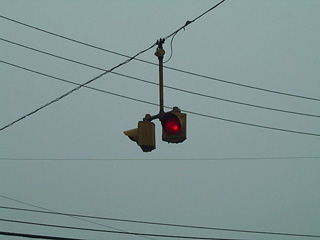
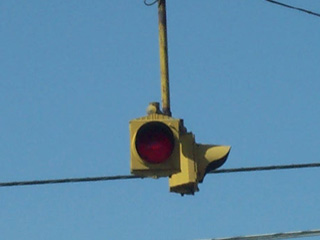
I have never found very many signals made by Crouse Hinds in my area. I mention a few above that are from the Art Deco era. Here is an example of the signal that followed the Art Deco. It is a 4 way cluster of Crouse Hinds type M signal heads. There are not very many of these around either. This is the only full 4 way cluster of them that I know of. There are stray singles or 2 ways here and there.
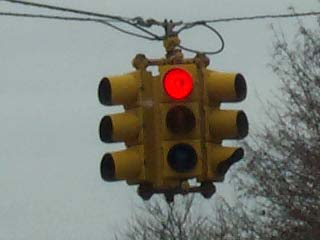
This web site is mostly devoted to signals, however, I do have some controller information on the pages about the NEMA, EF15 , EF70 and Crouse Hinds KS controllers in this collection. Because of this I thought it would be appropriate to show a photo of an Eagle electro-mechanical controller still in use near where I live. I do not know exactly what kind of controller this is, but it sounds exactly like the KERCHUNK noise that the two EF series controllers in my collection make. The cabinet even has the old STOP GO with flags logo that is found on older glass lenses found in older Eagle signal heads.
UPDATE: This controller cabinet was taken out of service on July 31st, 2003. It was left on the ground for several days for pick up along with the worn out poly signals it was controlling. The controller itself was an EF-70.
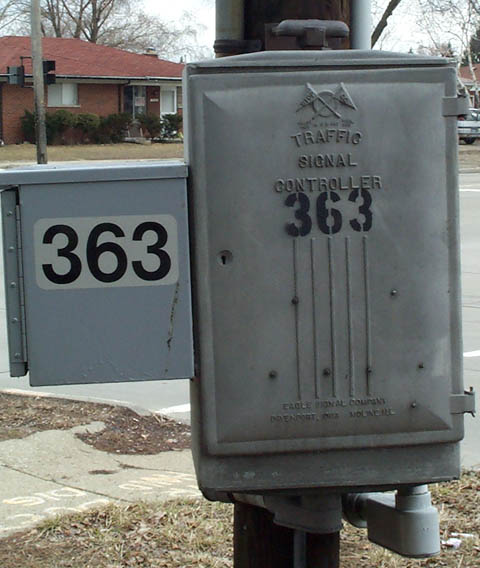
I do not know of any Red Yellow Green 4 way signals in the Detroit area anymore. The city of Royal Oak, Michigan used to have Eagle 4 ways, but they disappeared somewhere during the mid 1990's. The signal shown to the left below is one of the many that were used in Royal Oak. This signal was salvaged by a city worker and then it became part of The Traffic Signal Museum in July of 2006.
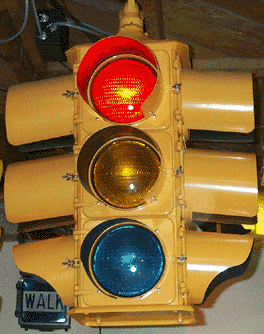
|
Below is a picture from this site, showing two Eagle 4 ways in Royal Oak. This is an older photo showing the signals with all cutaway visors unlike the signal to the left which only has cutaway visors on the green section. I only remember seeing the visor configuration used in Royal Oak as shown on the left. |
|
|
Here are two intersections of older Econolite and Eagle signals that are scheduled to be replaced soon.
First is an intersection with a couple of Econolite 3 way clusters with two single Eagles in between. These are located on Ryan road just north of 9 mile road in Warren. The first picture below is looking North on Ryan and the second is looking East on the side street.
Here are a couple close ups of one of the clusters.
These Econolites are some of the first produced by Econolite after they took over the G. E. brand. The first ones produced had the three grooves in the back that go all the way to the end of the casting. Later Econolite castings had grooves that stopped a few inches before the end of the casting.
There are also two pedestrian signals at this intersection. One is a newer 9 inch durasig which is not pictured. The other is an older aluminum Eagle 9 inch pedestrian signal with the extra long visors that Eagle pedestrian signals are known for. These used to be very prevalent in the Detroit area, but their numbers are dwindling very quickly.
UPDATE!
These signals were taken out of service on 02-06-2004. They were replaced with 12 inch LFE poly signals with red and green LED's and LED pedestrian signals. A modern electronic controller was also installed.
Just up the road about a half mile is the other intersection that will soon be updated. This leads to a school. It is served by two 3 way Eagle clusters and another older Eagle 9 inch pedestrian signal. There is also an auxiliary Eagle signal identical to the ones in the clusters that is not pictured. Also not pictured are a durasig vehicle and pedestrian signal on a pole on the opposite side of the street from the older Eagle 9 inch pedestrian signal that is pictured.
Here are close ups of both clusters
The 9 inch Eagle pedestrian signal has a push button on the pole. When the electro mechanical controller that controls these signals is in flash mode, pushing the button will bring the controller out of flash mode and the signals will cycle through both phases once so a pedestrian can cross the street and then the controller and signals go back into flash mode.
UPDATE!
These signals were taken out of service on 10-02-2003. They were replaced with 12 inch LFE poly signals with red and green LED's and LED pedestrian signals. A modern electronic controller was also installed.
Here is a signal that is also a "rare bird" in the Detroit area. This is a 3M pedestrian signal with symbolic indications. This head has a twin across the street from it. Other than these two, I don't know of any other 3M pedestrian signals in my area. There are a few stray 3M vehicle signals, but even those are becoming scarce!
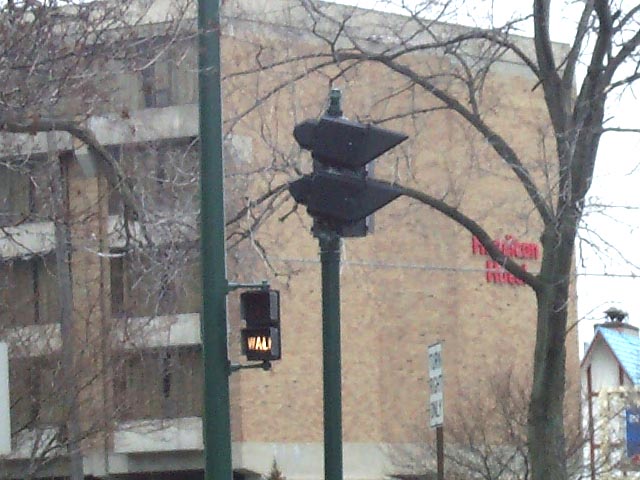
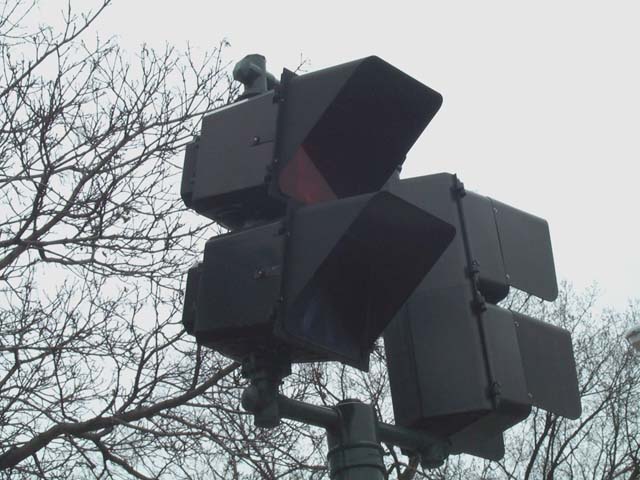
In April of 2007 I found this rare signal attachment. It is a Crouse Hinds 8" model R with an Eagle 12" enlarger unit attached.
One bright and sunny, but cold day in February, 2009, another signalfan named Ryan was nice enough to take me and 2 other signalfans for a ride up to Pontiac, Michigan where we found these two 3 way clusters of Crouse Hinds art deco signals still in service!


This page was originally posted on 4/20/2002.
